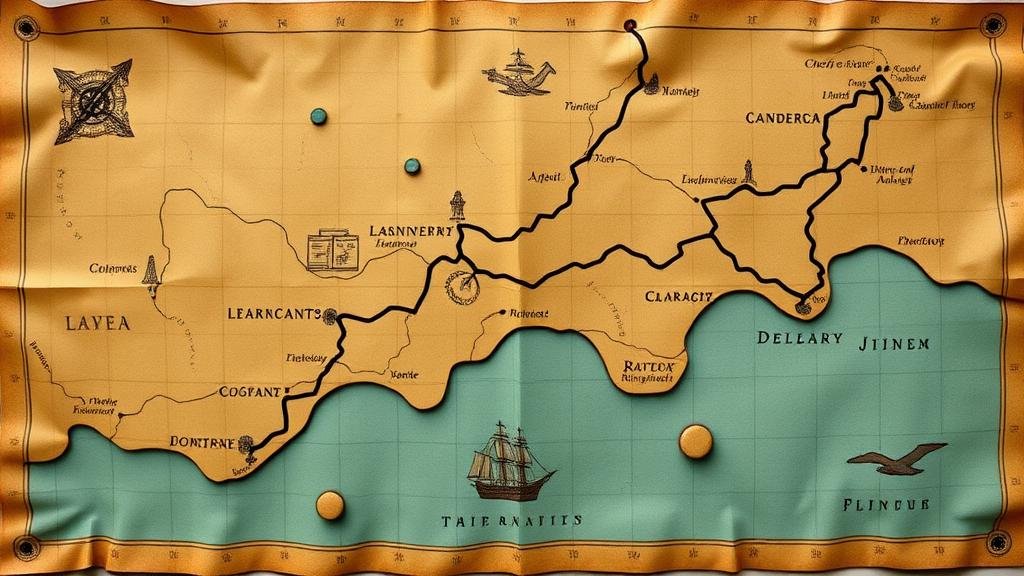How to Navigate Treasure Maps That Incorporate Dangerous Routes
How to Navigate Treasure Maps That Incorporate Dangerous Routes
Navigating treasure maps is an age-old practice laden with risk and excitement. Integrating dangerous routes into these navigational endeavors requires a keen understanding of both the physical landscape and strategic decision-making. This article aims to provide an in-depth guide on how to traverse such maps safely and effectively, combining historical context, modern techniques, and practical applications.
Understanding Treasure Maps
Treasure maps are more than mere drawings; they are sophisticated guides rooted in history, myth, and adventure. Traditionally, these maps have depicted hidden treasures, often located in remote or perilous areas. A study by the Journal of Historical Cartography notes that the studious analysis of treasure maps can often reveal clues about the environment, geological features, and cultural significance dating back centuries. For example, maps leading to pirate gold frequently incorporate coastal areas, as pirates favor locations that offer concealment and easy escape routes.
Identifying Dangerous Routes
Dangerous routes on treasure maps are typically characterized by significant obstacles, such as rugged terrain, wildlife, environmental hazards, and political instability in the region. To identify these routes effectively, one can employ several methodologies:
- Assessing Topography: Utilizing tools like topographical maps and GPS devices can clarify the landscapes challenges.
- Analyzing Historical Records: Understanding past expeditions through journals or logs can provide invaluable insights into encountered dangers.
- Consulting Local Experts: Engaging with local historians or geographers who have firsthand knowledge of the area can afford practical advice.
Preparing for the Expedition
Preparation is paramount when navigating dangerous routes on treasure maps. Depending on the identified risks, one must adequately equip themselves both physically and mentally. Key areas of focus include:
- Safety Gear: Essential equipment such as helmets, GPS trackers, first-aid kits, and reliable footwear can mitigate risks significantly.
- Emergency Plans: Establishing clear evacuation plans and sharing your itinerary with trusted individuals can enhance your safety.
- Gathering Information: Create a dossier of weather forecasts, local fauna, and flora, and emergency contacts before heading into the field.
Techniques for Navigation
Effective navigation through dangerous routes requires both traditional and modern techniques. Using a combination of these methods allows for a more well-rounded approach:
- Compassing and Map Reading: Mastering the fundamentals of compass navigation, including bearing, declination, and triangulation, is crucial.
- Utilizing Technology: Mobile navigation apps and satellite imagery provide real-time data that can assist in avoiding perilous areas.
- Landmark Navigation: Identifying and utilizing natural landmarks can guide navigators through challenging terrain when technology fails.
Real-World Case Studies
A recorded expedition that illustrates the principles discussed is the treasure hunt for Captain Kidds buried treasure on Gardiners Island. Adventurers have faced dangers like changing tides and treacherous ground while seeking the loot. By preparing through research, employing various navigation techniques, and respecting the natural environment, successful treasure seekers have emerged while adhering to safety protocols. According to a 2021 survey of treasure hunters, 78% highlighted thorough route planning as the primary factor in their successful recoveries.
Conclusion: Actionable Takeaways
Navigating dangerous routes on treasure maps is an enthralling pursuit, but it requires preparation, knowledge, and a respect for the potential hazards involved. Here are actionable takeaways to ensure a successful and safe adventure:
- Research thoroughly before embarking on any expedition.
- Equip yourself with the necessary tools and safety gear.
- Use both traditional navigation methods and modern technology.
- Always have contingency plans and communicate your whereabouts to others.
With the right preparation and techniques, the thrilling allure of seeking treasure can become a fulfilling adventure, rather than a perilous gamble.



